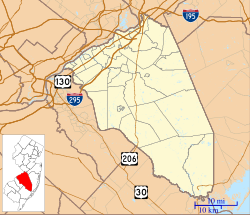Smithville, Burlington County, New Jersey
Smithville, New Jersey | |
|---|---|
 Smithville Schoolhouse | |
| Coordinates: 39°59′09″N 74°44′55″W / 39.98583°N 74.74861°W | |
| Country | |
| State | |
| County | Burlington |
| Township | Eastampton |
| Elevation | 39 ft (12 m) |
| Time zone | UTC-5 (Eastern (EST)) |
| • Summer (DST) | UTC-4 (EDT) |
| ZIP code | 08060[2] |
| Area code | 609 |
| GNIS feature ID | 880667[1] |
Smithville was a village in Eastampton Township, Burlington County, New Jersey.[3] It was originally established as Shreveville in 1831 by Jonathan and Samuel Shreve as a textile village on the Rancocas Creek.[3] It was purchased by Hezekiah Bradley Smith in 1865 and renamed to Smithville.[3] The Smithville post office was established in 1866.[4] The H. B. Smith Machine Company, which produced the American Star Bicycle beginning in 1880, was located there.[3] In 1962, the Smithville Post Office was closed. In 1975, Burlington County purchased the property and created the first park in the county.[3] It is listed on the National and New Jersey Registers of Historic Places as the Smithville Historic District.[5]
Bicycle railroad[edit]

In 1892, Arthur Hotchkiss received a patent for a bicycle railroad and contracted with the Smith Machine Company to manufacture it. The initial track ran 1.8 miles (2.9 km) from Smithville, in a nearly straight line, crossing the Rancocas Creek ten times, and arrived at Pine Street, Mount Holly. It was completed in time for the Mount Holly Fair in September 1892, and the purpose of the railway was supposed to have been enabling employees to commute quickly from Mount Holly to the factory at Smithville. Monthly commuter tickets cost $2.00. The record speed on the railway was 4.5 minutes, and the average trip took 6–7 minutes. The railway was exhibited at the World's Columbian Exposition in 1893. It only had one track so that it was impossible to pass another rider, and if riders traveling in opposite directions met, one had to pull off onto a siding. By 1897 ridership had declined, and the railway fell into disrepair.[3][6][7][8]
Notable people[edit]
People who were born in, residents of, or otherwise closely associated with Smithville include:
- Charles R. Chickering (1891-1970), freelance artist who designed 77 U.S. postage stamps while working at the Bureau of Engraving and Printing[9]
References[edit]
- ^ a b "Smithville". Geographic Names Information System. United States Geological Survey, United States Department of the Interior.
- ^ "Look Up a ZIP Code". United States Postal Service. Retrieved September 20, 2015. Used Smithville Road in Eastampton, NJ
{{cite web}}: CS1 maint: postscript (link) - ^ a b c d e f "Smithville Conservancy". H.B. Smith Industrial Village Conservancy. Archived from the original on September 25, 2011. Retrieved 2012-01-17.
- ^ Doug D’Avino (2011). "Smithville - Hezekiah B. Smith's Industrial Village". The Journal of the New Jersey Postal History Society. 39 (4). New Jersey Postal Historical Society: 198–210. ISSN 1078-1625. Archived from the original on September 25, 2011. Retrieved 2012-01-17.
- ^ "Historic Smithville Park". Burlington County Government. Retrieved 2012-01-17.
- ^ "The Bicycle Railroad and Its Inventor, Arthur Hotchkiss". New Jersey History's Mysteries. Archived from the original on 2012-02-05. Retrieved 2012-01-19.
- ^ Douglas Self. "Unusual Pedal Bicycles". The Museum of Retro Technology. Retrieved 2012-01-19.
- ^ "Of Bicycle Railroads and Moose-Drawn Carriages". Plankton Art Company. 29 June 2005. Archived from the original on 10 March 2012.
- ^ "Still life artist Peto led parade to retreat", Asbury Park Press, February 8, 1981. Accessed October 10, 2017. "Charles R. Chickering was born in Smithville in Burlington County in 1891 and at an early age moved with his family to Philadelphia."


